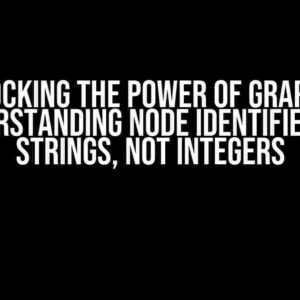Are you tired of dealing with complex data structures and struggling to access the information you need? Look no further! In this article, we’ll delve into the world of records and explore how to access an array of records within a record. By the end of this comprehensive guide, you’ll be a master of navigating records and extracting the data you need with ease.
What are Records?
In programming, a record (also known as a struct or tuple) is a composite data type that allows you to store multiple values of different data types in a single unit. Think of it like a container that holds multiple pieces of information, making it easier to organize and manipulate data.
Why Use Records?
Records offer several benefits, including:
- Improved code readability: By grouping related data together, records make your code more readable and understandable.
- Efficient data storage: Records allow you to store multiple values in a single unit, reducing memory usage and improving performance.
- Flexible data manipulation: Records make it easy to add, remove, or modify individual fields or values.
The Power of Arrays within Records
But what if you need to store multiple instances of a record? That’s where arrays come in! By combining records with arrays, you can create a powerful data structure that allows you to store and access multiple records with ease.
Declaring an Array of Records
To declare an array of records, you’ll need to define the record type and then specify the array size. Here’s an example in a fictional programming language:
record Person {
string firstName;
string lastName;
int age;
}
Person[] people = new Person[5];In this example, we define a record type called `Person` with three fields: `firstName`, `lastName`, and `age`. Then, we declare an array of `Person` records called `people` with a size of 5.
Accessing an Array of Records within a Record
Now that we have our array of records, let’s talk about how to access individual records within the array.
Index-Based Access
One way to access an individual record within the array is by using an index. Think of it like accessing an element in a regular array:
people[0].firstName = "John";
people[1].lastName = "Doe";
people[2].age = 30;In this example, we access the first, second, and third records in the `people` array using their index (0, 1, and 2, respectively). We can then assign values to individual fields within each record.
Enum-Based Access
Another way to access an individual record within the array is by using an enumeration. This method is particularly useful when you need to iterate over the array:
for (int i = 0; i < people.length; i++) {
people[i].firstName = "Person " + i;
people[i].lastName = "Lastname " + i;
people[i].age = i * 10;
}In this example, we use a `for` loop to iterate over the `people` array, accessing each record using the enumeration variable `i`. We can then assign values to individual fields within each record based on the current index.
Real-World Applications
So, why would you want to access an array of records within a record? Here are a few real-world scenarios:
| Scenario | Description |
|---|---|
| Students in a Classroom | Store information about students in a classroom, including their names, grades, and attendance records. |
| Products in an E-commerce Store | Store product information, including product names, descriptions, prices, and inventory levels. |
| Employees in a Company | Store employee information, including names, job titles, departments, and salary records. |
In each of these scenarios, accessing an array of records within a record allows you to efficiently store and manipulate complex data structures.
Best Practices
When working with arrays of records within records, keep the following best practices in mind:
- Use meaningful variable names: Choose variable names that accurately reflect the data they contain.
- Document your code: Clearly comment your code to help others understand how the data structures work.
- Test thoroughly: Thoroughly test your code to ensure it’s working as expected.
Conclusion
Accessing an array of records within a record is a powerful technique that can help you efficiently store and manipulate complex data structures. By following the instructions and explanations in this article, you’ll be well on your way to mastering records and arrays. Remember to keep your code organized, readable, and well-documented, and don’t be afraid to experiment and try new things!
Happy coding!
Frequently Asked Question
Stuck on accessing array of records within a record? Don’t worry, we’ve got you covered! Here are the answers to your most burning questions.
How do I access an array of records within a record in a programming language?
To access an array of records within a record, you need to use the dot notation or array indexing depending on the programming language you’re using. For example, in JavaScript, if you have a record `user` with an array of `orders` records, you can access it like this: `user.orders[0].orderTotal`. In other languages, you may need to use a different syntax, but the concept remains the same.
What if the array of records is nested within another array or record?
No problem! Just keep using the dot notation or array indexing to drill down to the level you need. For example, if you have a record `customer` with an array of `accounts` records, and each `account` has an array of `transactions` records, you can access it like this: `customer.accounts[0].transactions[0].amount`. Just keep going until you reach the data you need!
Can I use loops to access and manipulate the array of records?
Absolutely! Loops are a great way to access and manipulate arrays of records. You can use a `for` loop, `foreach` loop, or even a `map` or `filter` function depending on the language and your needs. For example, if you want to calculate the total order value for all orders in the `user.orders` array, you can use a `forEach` loop like this: `user.orders.forEach(order => total += order.orderTotal)`. Easy peasy!
How do I know if I’m accessing the correct record or array index?
Great question! It’s essential to debug and validate your code to ensure you’re accessing the correct record or array index. Use console logs, debuggers, or print statements to inspect the data and verify that you’re getting the expected results. You can also use tools like JSON viewers or debuggers to visualize the data structure and navigate to the correct record or array index.
What if I’m dealing with a large array of records and performance becomes an issue?
When dealing with large datasets, performance can become a concern. To optimize performance, consider using techniques like pagination, caching, or lazy loading to reduce the amount of data being processed. You can also use libraries or frameworks that provide optimized data structures and algorithms for working with large datasets. Additionally, consider using parallel processing or distributed computing if you need to perform complex computations on the data.




